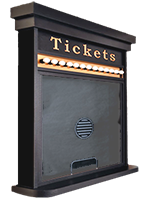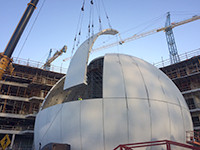What to charge, and squishy pricing models
So, what to charge? It’s THE basic question. How much is a show worth? What price tag do you put on it?
The simple answer is: you charge what you think the market will bear and what the customer can afford to pay.
 Of course, the hard part comes in estimating the size of the customer’s wallet, and how willing they are to part with their money. You need some form of evaluation, some metric, to help you determine just how much to charge customers.
Of course, the hard part comes in estimating the size of the customer’s wallet, and how willing they are to part with their money. You need some form of evaluation, some metric, to help you determine just how much to charge customers.
I’m not sure who came up with the first pricing models. Nobody I’ve asked has admitted it, anyway. But those initial models have been quite pervasive; they were followed by almost all of the early producers. Still, there was obviously some guesswork done, based on some general assumptions.
Here is ASSUMPTION #1:
Bigger theaters must be a more lucrative market than smaller theaters. Almost all of them charge admission to their shows; they have an apparent income stream that can be tapped into. The more people that come through the doors, the more money the theater takes in. Bigger theaters must, therefore, have more money to spend on shows than smaller theaters. So bigger theaters should get charged higher prices than smaller theaters.
I think that assumption is flawed in several ways, however.
While the big theaters definitely did pay a lot for their construction and equipment, that was a capital expense they made once. It does not necessarily mean they have current operating budgets to match. They might, they might not. We’ve seen more than a few facilities put all their available funding into the physical plant, then have to run on a budgetary shoestring thereafter, because they didn’t plan for continued expenses such as programming.
 In terms of people coming through the doors — some planetaria don’t charge admission or sell tickets. Some in museums don’t charge separate admission; the entrance to the planetarium is included as part of the museum ticket. Some don’t present shows to the general public, only student groups. Some presenting public shows may only do so once a week, or once a month.
In terms of people coming through the doors — some planetaria don’t charge admission or sell tickets. Some in museums don’t charge separate admission; the entrance to the planetarium is included as part of the museum ticket. Some don’t present shows to the general public, only student groups. Some presenting public shows may only do so once a week, or once a month.
And in my experience, the big theaters complain about their poor budgets just as much as the little theaters.
(Aside — it’s often thought, especially from those outside the field, the “gate-share” model would be viable. That’s where the income from ticket sales is shared by the various parties involved — the producer, the distributor, the theater, etc. It’s common in traditional theaters, concert halls, and the like. But most planetaria are currently not run like those venues, and their institutional structures are not set up that way. Gate-share only works when there is a sizable gate to share. When the count isn’t verifiable, when shows aren’t presented regularly, when there isn’t a box office selling tickets, gate-share is a non-starter.)
Finally, what does “bigger” really mean? Physical size? Well, dome diameter is often used as a measurement. Usually, the larger the dome, the more seats can be stuffed in under it. In theory, that should mean the bigger domes serve more people. In practice, it just means they have the capacity to hold more seats; that doesn’t necessarily mean those additional seats are actually there. And whatever the seat count, it’s no indication of whether warm bodies are actually sitting in them.
Still, some distributors and producers base their price structure on a theater’s “bigness”. We don’t think it makes good sense, and we prefer to use a different method. Which I’ll get to on the next page.
===============
ASSUMPTION #2 follows from ASSUMPTION #1:
If bigger theaters have bigger budgets, smaller theaters must therefore have smaller budgets — and portables, being the smallest, must therefore be impoverished. After all, their hardware costs were so small, apparently they couldn’t afford anything bigger and better. Only a few kids at a time can squeeze inside an inflatable dome, so their attendance must be really low. If they were selling tickets, there wouldn’t be making much money, and they usually don’t charge admission anyway. So when it comes to licensing movies, portables are somehow deserving of a lower price than fixed-dome theaters.
The “give a break to the poor portables” idea is pervasive in many distributors’ price grids. Licenses for shows playing in portable domes can sometimes be one-tenth the price of what the big theaters get charged.
Big theaters have noticed this, and some object to “subsidizing” the smaller ones. They argue, “Why should I have to pay so much more for the same movie, just because my dome is bigger? The little guys are getting  an unfair advantage, at my expense!”
an unfair advantage, at my expense!”
I think this idea, too, is based on a flawed assumption. Which I’ll get to next.
===================
ASSUMPTION #3 takes the “portables = poor” idea to an extreme. It says:
If the dome is inflatable, its movies should be priced much less than for any fixed-dome facility.
We’ll ignore the point that the material the dome is made of cannot possibly have a bearing on the cost of the movie being projected on it. A bigger problem is this: the distinction is fuzzy between “fixed theaters” and “portables” overall.
Digitalis Education Solutions is known for providing the world’s most popular portable fulldome projectors. Yet they tell me that one-third of their sales are for the same projectors installed in fixed domes, not in portable ones. A customer of ours operates a theater in Texas with a Digitalis system. They have a fixed dome theater — but they also pack their Digitarium out into their van and take it around to schools with an inflatable dome. Are they portable? Fixed? Should a movie installed on their system cost them a different price depending on where they set up the projector? Why?
Another customer at an Indiana museum keeps their Digitarium projector on a cart in a closet. Their fiberglass dome is suspended on cables and pulleys; they lower it down from the ceiling and wheel the projector cart into position under the dome when they want to use it. Portable? Fixed? Who decides? What difference should it make to the movie’s price?
We’ve had customers rightfully complain how their small fixed dome is basically the same size as the portable that goes around to the schools in the next town over, yet they’re required to pay double the price for the exact same movie, simply because their dome is bolted to the ceiling instead of bouncing on the floor. We’re on their side, actually; we think it’s unfair too.
The industry’s perceived image of small theaters being small in budget does not necessarily jibe with reality. Pat Reiff from ePlanetarium counters the poverty idea quite nicely. She points out that when Discovery Dome customers pay less for their projector systems — especially those with relatively inexpensive spherical mirror setups — they have MORE money to spend on other things… like our movies! They haven’t exhausted their entire budget on hardware.
=================
ASSUMPTION #4 also follows from ASSUMPTION #1, and it’s the most pernicious. It seems to start out reasonably, but the logic unravels as you read along:
The better-attended the theater is, the more successful it must be. If they’re serving more people, then the audience for any particular show must be larger. Let’s simply tally up their overall attendance, say on an annual basis. Even if they’re not charging admission, it just seems the theater ought to have more money to play with. So if a theater is really popular and sees a lot of people come through the doors each year, the license fees should be higher for them. If they’re not very popular and they serve fewer people, they shouldn’t pay as much.
Even though the assumption is clearly flawed, for the sake of argument, let’s play along.
Let’s say a theater shows a really popular film from one producer and lots of people come to see it. Why should that have any bearing on the price another producer gets for a different show? Conversely, if a show does poorly for a theater and has low attendance, why should that affect the price paid for the show that follows?
Why should an accumulated attendance for an entire year, from who-knows-what variety of programming, affect any price paid to a producer for a specific show?
Worse, this pricing scheme has the effect of penalizing the good theaters and rewarding the bad. Let’s say a theater does a great job promoting itself and its shows, and brings in lots of people. These theaters are then given the disincentive of having to pay more for their shows. Compare that to a theater that offers poor presentations, does a lousy job of promotion, and sees fewer people as a result. They get rewarded by being able to buy shows for a lower price than their better-performing colleagues. That seems totally backward and unfair.
 Then there is the question of just what is meant by “annual attendance”. It’s not clearly defined anywhere. Does it mean only the screenings for a particular fulldome show title, or all fulldome shows combined? Only public shows? What about school groups? Do audiences that don’t see a show but instead get a live presentation count? Laser shows too? What about special events where audiences don’t see any shows — weddings, concerts, lectures, funerals, all that — do they count as well? And why? No one has ever said, definitively.
Then there is the question of just what is meant by “annual attendance”. It’s not clearly defined anywhere. Does it mean only the screenings for a particular fulldome show title, or all fulldome shows combined? Only public shows? What about school groups? Do audiences that don’t see a show but instead get a live presentation count? Laser shows too? What about special events where audiences don’t see any shows — weddings, concerts, lectures, funerals, all that — do they count as well? And why? No one has ever said, definitively.
If we’re talking about the price for a specific fulldome movie, how or why should the attendance at anything other than that movie have any effect on its price? I say: it doesn’t, and it shouldn’t.
The only time a producer might care about how many people the end-user brings in would be if they were using the gate-share model, where they receive a percentage of the ticket sales. Since most fulldome theaters cannot operate that way, the primary reason for using an attendance-based pricing model collapses ignominiously.
Actually, the “annual attendance” model breaks down big time in other ways too.
 What if a theater is new, and they haven’t had a year’s worth of attendance to tally up? Those producers who are so adamant about keeping to the “attendance model” quickly chuck it out the window in those cases. They revert to ASSUMPTION #1 above and make their guesses about how much the customer can afford by counting up how many seats got installed. The more, the merrier — except we know where that leads.
What if a theater is new, and they haven’t had a year’s worth of attendance to tally up? Those producers who are so adamant about keeping to the “attendance model” quickly chuck it out the window in those cases. They revert to ASSUMPTION #1 above and make their guesses about how much the customer can afford by counting up how many seats got installed. The more, the merrier — except we know where that leads.
Small theaters, particularly in the school market where many of them operate, often don’t keep track of how many people they see each year, especially those with portable systems. They don’t sell tickets or charge admission; there’s simply no need or incentive for them to count. And of course, in portables, one cannot count seats if there aren’t any.
So these people have to guess at their numbers or make them up. And if the higher they place their guesses means it costs them more money, which way do we expect they will guess?
Then there are those institutions that don’t sell separate tickets for the dome theater; the planetarium show is included in the museum admission price, not called out separately. The entire museum’s attendance figure might be available, but not the planetarium’s.
I’m amazed to hear some of the contorted-logic arguments from the big theaters with the multiple cinema projectors when they claim they should be paying the same prices as the smallest portable theaters. They may have 200 seats in their theater, but they claim to have only 30 people on average sitting in them.
On the other hand, I had one customer actually say that because prices for Loch Ness Productions shows were so reasonable, it seemed unfair that big theaters were getting such a good deal!
Some producers have created complex pricing structures, with grids containing sometimes-contradictory levels of dome size, seating capacity and those ambiguous annual attendance figures. These leave some theater operators confused, stymied trying to figure out where they might qualify — as in this actual correspondence from a customer: “I’d call us medium or large size, based on dome and seats, but we’re definitely small in terms of annual attendance and off the bottom of the chart in terms of budget. [Your competitor] follows a similar pricing schedule and I think we’re a medium with them, based more on seat numbers.”
Say what???!!! 🙂
Predictably, there is incentive for the theater operator to fudge their figures to get a lower price. We’ve run into this in competitive-bid situations for movies. When we ask a theater operator for their annual attendance figure, the number we get differs from what has been published elsewhere — the institution’s own press releases or brochures, for example. We have to rely on the word of the theater operator as to what their attendance is.
Finally, by whatever calculations and aerial excavations are used, when an attendance figure is ultimately provided, we have no way of verifying how accurate it is. It’s simply un-policeable. So why bother?
In the end, the producer does not really care what the true attendance figure is anyway. All they want to know is which tier of their pricing grid their money is coming from. The reported attendance level determines which license fee they get, but what the actual attendance number is just doesn’t matter.
Thus, the “annual attendance” model, based on illogical assumptions, leaves us dealing with the ambiguity of a customer’s reporting of an undefined, unverifiable and ultimately irrelevant metric.
When fulldome movies can be priced in the tens of thousands of dollars, having to rely on such a squishy system doesn’t strike us as being the most robust way of doing business.
We prefer to do things differently. Which I’ll get to on the next page.
Page 1 – Overview
Page 2 – Who produces fulldome movies
Page 3 – What to charge, and squishy pricing models
Page 4 – Our firm T-shirt size pricing model
Page 5 – Publishing prices and objections
Page 6 – Varying license terms


4 Responses to Fulldome Show Pricing – In Depth